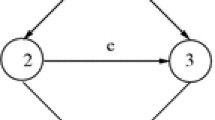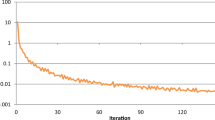Abstract
Studies of network vulnerability mostly focus on changes to the supply side; whether considering a degradation of link capacity or complete link failure. However, the level of service provided by a transport network is also vulnerable to increases in travel demand, with the consequent congestion causing additional delays. Traffic equilibrium models can be used to evaluate the influence of travel demand on level of service when interest is restricted to only a small number of pre-specified demand scenarios. A demand-vulnerability analysis requires understanding the impact of unknown future changes to any possible combination of OD demands. For anything but the smallest networks, this cannot be accomplished by re-computing network equilibrium at all possible demand settings. We require a representation of the functional relationship between demands and levels of service, avoiding the need to re-evaluate the equilibrium model. This process—of collapsing the demand and network representations onto a single, coarse-level network with explicit functional relationships—is referred to here as ‘network aggregation’. We present an efficient method for network aggregation for networks operating under Stochastic User Equilibrium (SUE). In numerical experiments, we explore the nature and extent of the aggregation errors that may arise.



















Similar content being viewed by others
Notes
Our classification covers only those approaches which begin with a discrete graph representation and aim for some kind of simplified representation from that graph. Hence, although they have some relation, we exclude from this classification continuum models, whereby a dense urban network is represented as a continuum, with flows comprising a vector field (e.g. Dafermos 1980; Wong 1998; Daniele, Idone and Maugeri 2003).
Indeed the equilibrium link flows and costs themselves cannot typically be expressed as explicit functions of the network parameters and OD demands.
While a map is provided on Bar-Gera’s website the map node numbers do not match the data file(s) and hence it cannot be used to identify ODs.
References
Ardekani S, Herman R (1987) Urban network-wide traffic variables and their relations. Transp Sci 21(1):1–16
Batty M, Sikdar PK (1982a) Spatial aggregation in gravity models: 1. An information-theoretic framework. Environ Plan A 14(3):377–405
Batty M, Sikdar PK (1982b) Spatial aggregation in gravity models: 2. One-dimensional population density models. Environ Plan A 14(4):525–553
Batty M, Sikdar PK (1982c) Spatial aggregation in gravity models: 3. Two-dimensional trip distribution and location models. Environ Plan A 14(5):629–658
Batty M, Sikdar PK (1982d) Spatial aggregation in gravity models: 4. Generalizations and large-scale applications. Environ Plan A 14(6):795–822
Bell MGH, Iida Y (1997) Transportation network analysis. Wiley, Chichester
Bell MGH (2000) A game theory approach to measuring the performance reliability of transport networks. Transportation Research Part B: Methodological 34(6):533–545
Berdica K (2002) An introduction to road vulnerability: what has been done, is done and should be done. Transp Policy 9:117–127
Bouthelier F, Daganzo CF (1979) Aggregation with multinomial probit and estimation of disaggregate models with aggregate data—a new methodological approach. Transp Res B Methodol 13(2):133–146
Bovy PHL, Jansen GRM (1983) Network aggregation effects upon equilibrium assignment outcomes: an empirical investigation. Transp Sci 17(3):240–262
Boyles SD (2012) Bush-based sensitivity analysis for approximating subnetwork diversion. Transp Res B Methodol 46(1):139–155
Cantarella GE (1997) A general fixed-point approach to multimode multi-user equilibrium assignment with elastic demand. Transp Sci 31(2):107–128
Chan Y (1976) Method to simplify network representation in transportation-planning. Transp Res 10(3):179–191
Chang KT, Khatib Z, Ou YM (2002) Effects of zoning structure and network detail on traffic demand modeling. Environ Plan B-Plan Des 29(1):37–52
Chen A, Yang H, Lo HK, Tang WH (2002) Capacity reliability of a road network: an assessment methodology and numerical results. Transp Res 36B(3):225–252
Chen BY, Lam WHK, Sumalee A, Li Q, Li Z-C (2012) Vulnerability analysis for large-scale and congested road networks with demand uncertainty. Transp Res A 46:501–516
Clark SD, Watling DP (2002) Sensitivity analysis of the probit-based stochastic user equilibrium assignment model. Transp Res B 36(7):617–635
Connors RD, Sumalee A, Watling DP (2007) Sensitivity analysis of the variable demand probit stochastic user equilibrium with multiple user-classes. Transp Res B Methodol 41(6):593–615
D’Este GM, Taylor MAP (2001) Modelling network vulnerability at the level of national strategic transport network. J East Asia Soc Transp Stud 4(2):1–14
Dafermos S (1980) Continuum modeling of transportation networks. Transp Res B Methodol 14(3):295–301
Daganzo CF (1980a) An equilibrium algorithm for the spatial aggregation problem of traffic assignment. Transp Res B Methodol 14(3):221–228
Daganzo CF (1980b) Network representation, continuum approximations and a solution to the spatial aggregation problem of traffic assignment. Transp Res B Methodol 14(3):229–239
Daganzo CF (2007) Urban gridlock: macroscopic modeling and mitigation approaches. Transp Res B Methodol 41(1):49–62
Daganzo CF, Geroliminis N (2008) An analytical approximation for the macroscopic fundamental diagram of urban traffic. Transp Res B Methodol 42(9):771–781
Daniele P, Idone G, Maugeri A (2003) The continuum model of transportation problem. Daniele P, Giannessi F, and Maugeri A (eds)
Davis G (1994) Exact local solution of the continuous network design problem via stochastic user equilibrium assignment. Transp Res B Methodol 28(1):61–75
Friesz T (1985) Transportation network equilibrium, design and aggregation—key developments and research opportunities. Transp Res Policy Pract 19(5–6):413–427
Hearn DW (1984) Practical and theoretical aspects of aggregation problems in transportation planning methods. In: Florian M (ed) Transportation planning models. North-Holland, Amsterdam, pp 257–287
Herman R, Prigogine I (1979) A two-fluid approach to town traffic. Science 204(4389):148–151
Hills PJ (2001) Supply curves for urban road networks—a comment. J Transp Econ Policy 35:343–348
Ho HW, Sumalee A, Lam WHK, Szeto WY (2013) A continuum modelling approach for network vulnerability analysis at regional scale. Pap ISTTTProcedia Soc Behav Sci 80:846–859
Jenelius E, Petersen T, Mattsson L-G (2006) Importance and exposure in road network vulnerability analysis. Transp Res A 40:537–560
Knoop VL, Snelder M, Van Zuylen HJ, Hoogendoorn SP (2012) Link-level vulnerability indicators for real-world networks. Transp Res A 46:843–854
Lam WHK, Shao H, Sumalee A (2008) Modeling impacts of adverse weather conditions on a road network with uncertainty in demand and supply. Transp Res A 42(10):890–910
Lighthill M, Whitham G (1955) On kinematic waves.2. A theory of traffic flow on long crowded roads. Proc R Soc Lond Ser Math Phys Sci 229(1178):317–345
May AD, Shepherd SP, Bates JJ (2000) Supply curves for urban road networks. J Transp Econ Policy 34:261–290
May AD, Shepherd SP, Bates JJ (2001) Supply curves for urban road networks—a rejoinder. J Transp Econ Policy 35:349–352
Nakayama S, Watling DP (2014) Consistent formulation of network equilibrium with stochastic flows. Trans Res B
Nicholson AJ, Dalziell E (2003) Risk evaluation and management: a road network reliability study. In: Iida B (ed) ‘The network reliability of transport’. Pergamon-Elsevier, Oxford, pp 45–59
Openshaw S (1977) Optimal zoning systems for spatial interaction models. Environ Plan A 9(2):169–184
Patriksson M (2004) Sensitivity analysis of traffic equilibria. Transp Sci 38(3):258–281
Rogers DF, Plante RD, Wong RT et al (1991) Aggregation and disaggregation techniques and methodology in optimization. Oper Res 39(4):553–582
Sbayti H, El-Fadel M, Kaysi I (2002) Effect of roadway network aggregation levels on modeling of traffic-induced emission inventories in Beirut. Transp Res Part D: Transp Environ 7(3):163–173
Shao H, Lam WHK, Tam ML (2006) A reliability-based stochastic traffic assignment model for network with multiple user classes under uncertainty in demand. Netw Spat Econ 6:173–204
Sheffi Y (1984) Aggregation and equilibrium with multinomial logit-models. Appl Math Model 8(2):121–127
Sheffi Y (1985) Urban transportation networks. Prentice-Hall, Englewood Cliffs
Smith MJ (1979) The existence, uniqueness and stability of traffic equilibria. Transp Res B Methodol 13(4):295–304
Sullivan JL, Novak DC, Aultman-Hall L, Scott DM (2010) Identifying critical road segments and measuring system-wide robustness in transportation networks with isolating links: a link-based capacity-reduction approach. Transp Res A 44:323–336
Sumalee A (2004) Optimal road user charging cordon design: a heuristic optimization approach. Comput Aided Civ Infrastruct Eng 19(5):377–392
Sumalee A, Watling DP (2008) Partition-based algorithm for estimating transportation network reliability with dependent link failures. J Adv Transp 42(3):213–238
Sumalee A, Uchida K, Lam WHK (2011) Stochastic multi-modal transport network under demand uncertainties and adverse weather condition. Transp Res C 19(2):338–350
Szeto WY, O’Brien L, O’Mahony M (2006) Risk-averse traffic assignment with elastic demands: NCP formulation and solution method for assessing performance reliability. Netw Spat Econ 6:313–332
Taylor MAP, Somenahalli VCS, D’Este GM (2006) Application of accessibility based methods for vulnerability analysis of strategic road networks. Netw Spat Econ 6:267–291
Theil H (1957) Linear aggregation in input–output analysis. Econometrica 25(1):111
Tsekeris T, Geroliminis N (2013) City size, network structure and traffic congestion. J Urban Econ 76:1–14
Uchida K (2014) Estimating the value of travel time and of travel time reliability in road networks. Transp Res B. doi:10.1016/j.trb.2014.01.002
Viegas JM, Martinez LM, Silva EA (2009) Effects of the modifiable areal unit problem on the delineation of traffic analysis zones. Environ Plan B-Plan Des 36(4):625–643
Wardrop JG (1952) Road paper. Some theoretical aspects of road traffic research. ICE Proc Eng Div 1(3):325–362
Watling DP, Balijepalli NC (2012) A method to assess demand growth vulnerability of travel times on road network links. Transp Res A 46:772–789
Wong SC (1998) Multi-commodity traffic assignment by continuum approximation of network flow with variable demand. Transp Res B Methodol 32(8):567–581
Wright I, Xiang Y, Waller L et al. (2010) The practical benefits of the Saturn Origin-based assignment algorithm and network aggregation techniques. In: Available from: http://trid.trb.org/view.aspx?id=1118347 (accessed 21 August 2013)
Xie F, Levinson D (2007) Measuring the structure of road networks. Geogr Anal 39(3):336–356
Xu Z, Sui DZ (2007) Small-world characteristics on transportation networks: a perspective from network autocorrelation. J Geogr Syst 9(2):189–205
Yang L, Qian D (2012) Vulnerability analysis of road networks. J Transp Syst Eng Inf Technol 12(1):105–110
Yang H, Lo HK, Tang WG (2000) Travel time versus capacity reliability of a road network. In: Bell MGH, Cassir C (eds) Reliability of transport networks. Research Studies, Baldock, pp 119–138
Zipkin PH (1980) Bounds for aggregating nodes in network problems. Math Program 19(1):155–177
Author information
Authors and Affiliations
Corresponding author
Appendix: Toy City Link Cost Function Parameters
Appendix: Toy City Link Cost Function Parameters
Rights and permissions
About this article
Cite this article
Connors, R.D., Watling, D.P. Assessing the Demand Vulnerability of Equilibrium Traffic Networks via Network Aggregation. Netw Spat Econ 15, 367–395 (2015). https://doi.org/10.1007/s11067-014-9251-9
Published:
Issue Date:
DOI: https://doi.org/10.1007/s11067-014-9251-9




